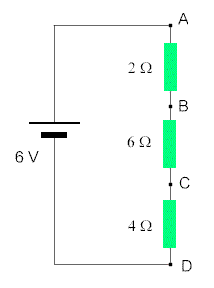
(In all that follows, the numbers have been chosen to make calculations easy. You should take the trouble to check that you agree with each numerical statement.)
The total resistance of the circuit on the left is 12 W.
This means that the current flowing is 0.5 A.
The p.d. across the top resistor is 1 V (using V = I R). This is one sixth of the total p.d. available. Furthermore, the resistance of the top resistor (2 W) is one sixth of the total resistance available (12 W).
The p.d. across the middle resistor is 3 V (using V = I R). This is a half of the total p.d. available. Furthermore, the resistance of the middle resistor (6 W) is a half of the total resistance available (12 W).
So the general rule is that the pd across a resistor is the same fraction of the total pd as the resistance is of the total resistance. Check that this rule works for the bottom resistor.
If we decide that the potential at D will have a value of 7 V, then the potential at C has to have the value 9 V, that at B must be 12 V, while that at A is 13 V. Check that the differences between these potentials (i.e. the pd's) are those calculated in the paragraphs above.
Usually, the potential at D would be taken as 0 V. What would the other potentials then be ?


